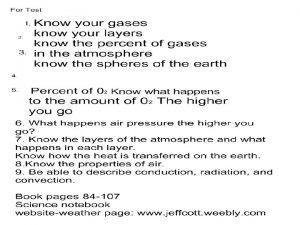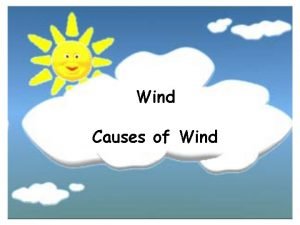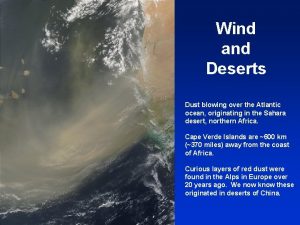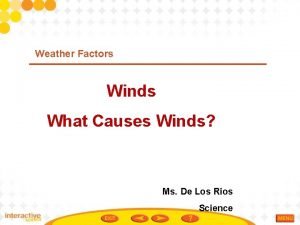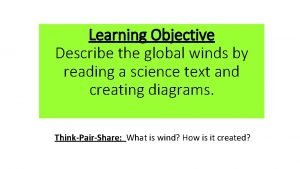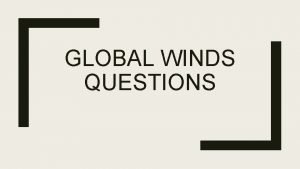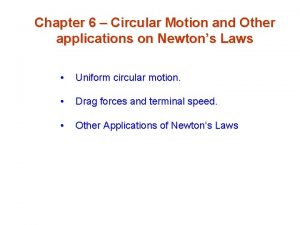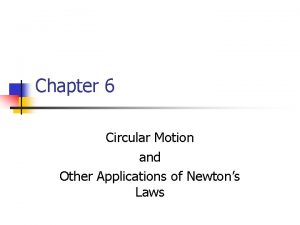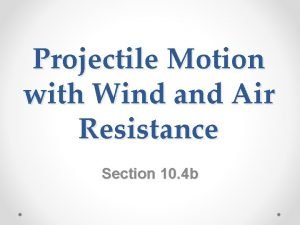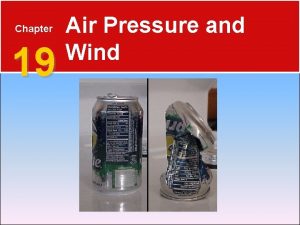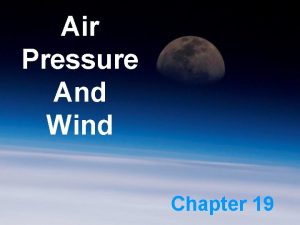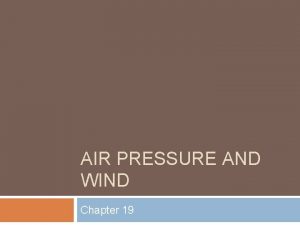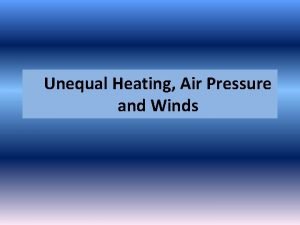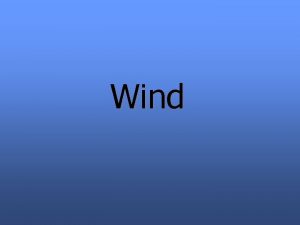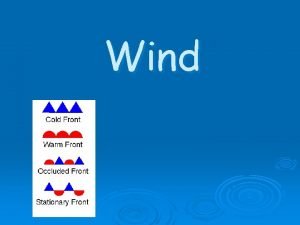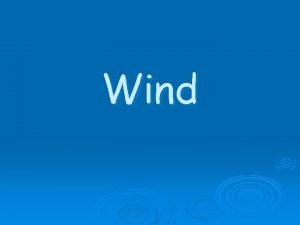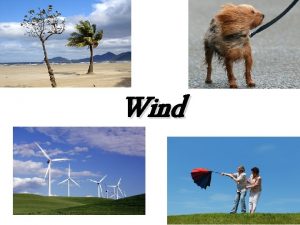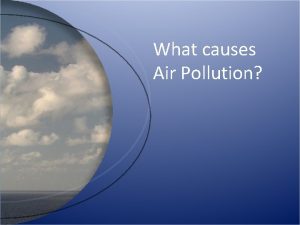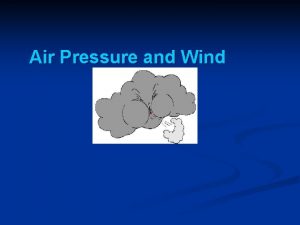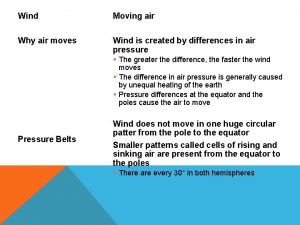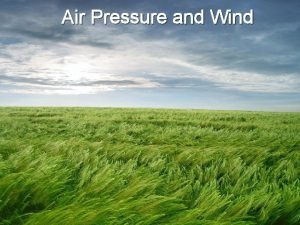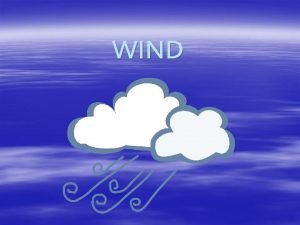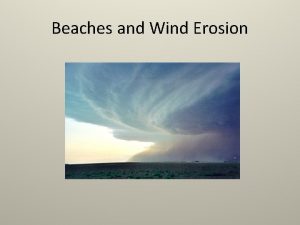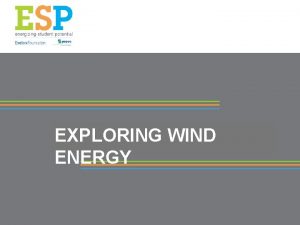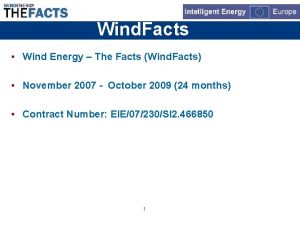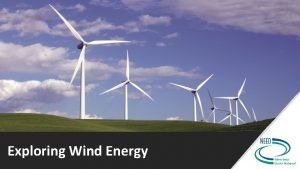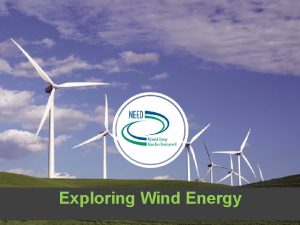What Causes the Wind Wind Air in motion




























- Slides: 28

What Causes the Wind

Wind: Air in motion produced by the uneven heating of earth’s surface by the sun

Anemometer: A device that measures wind speed


*****KEY CONCEPT***** Winds are named for the direction that they are coming from Example: A north wind in NYS usually brings cold air because it comes from Canada/the north.

Isobar: Line on a weather map connecting places with the same atmospheric pressure

Pressure gradient: Rate of change in air pressure between two points on a map Closer isobars= higher gradient=faster the winds

Coriolis Effect: Apparent bending of the winds, ocean currents or objects along Earth’s surface; caused by Earth’s rotation


Without rotation, winds would blow straight from areas of high pressure (North Pole) to areas of low pressure (equator)

Jet Stream: Currents of very fast winds in the stratosphere; separates hot air from warm air from cold air


Jet streams blow from west to east in mid-latitudes

Jet streams are important because they influence the development and movement of storm systems

Planetary Wind Belts (ESRT 14): Latitude zone of prevailing wind conditions Prevailing winds: Wind that blows more often from one direction than from any other

Prevailing Winds Difference in air pressure and prevailing winds can often mean different weather conditions

Much of the contiguous US is affected by planetary winds that blow from the southwest to the northeast As a result, weather in the US generally moves from SW to NE

DO NOT WRITE Example: In the winter, the northern portions of the US often get cold weather conditions from Canada caused by northerly prevailing winds. In the summer, the same regions usually have more southerly prevailing winds

Monsoons: A regular and extreme weather change caused by the shift of wind and pressure belts, which is directly related to the changes in seasons

DO NOT WRITE Example: India- when winds are off the land, India experiences a drought. When winds are off the water, India experiences high amounts of rain

Cool places usually have relatively high air pressure and warmer places have relatively lower air pressure

****KEY IDEA**** Winds always blow from areas of high pressure to areas of low pressure


During the day, land heats up quicker than water Warm air rising over land causes low pressure, a sea breeze and clouds over the land. This happens during the day.

Warm above slowly cooling water at night creates low pressure, a land breeze and clouds over the water. This happens at night.


Surface ocean currents are caused by wind blowing over the oceans and transferring energy to the water- huge impact on climate!

 Chapter 12 air section 1 what causes air pollution
Chapter 12 air section 1 what causes air pollution Chapter 12 air section 1 what causes air pollution
Chapter 12 air section 1 what causes air pollution Hubungan air dengan tanah
Hubungan air dengan tanah Proximate and ultimate causes of behaviour
Proximate and ultimate causes of behaviour Ultimate vs proximate causation
Ultimate vs proximate causation What does an anemometer measure
What does an anemometer measure What causes wind
What causes wind Global winds
Global winds What causes wind to blow
What causes wind to blow What causes wind to blow
What causes wind to blow Polar easterlies
Polar easterlies Which factor causes global wind patterns?
Which factor causes global wind patterns? What causes wind to blow brainpop
What causes wind to blow brainpop Wind von backbord weicht wind von steuerbord
Wind von backbord weicht wind von steuerbord What causes circular motion
What causes circular motion Circular motion applications
Circular motion applications What causes warm air to rise brainpop
What causes warm air to rise brainpop Air resistance formula
Air resistance formula A sea breeze usually originates during the
A sea breeze usually originates during the Chapter 19 air pressure and wind
Chapter 19 air pressure and wind Chapter 19 air pressure and wind wordwise answer key
Chapter 19 air pressure and wind wordwise answer key Winds
Winds What is the horizontal movement of air called
What is the horizontal movement of air called Passive rom vs active rom
Passive rom vs active rom Harmonic motion equation
Harmonic motion equation An object in motion stays in motion
An object in motion stays in motion Chapter 2 section 1 describing motion answer key
Chapter 2 section 1 describing motion answer key The main difference between speed and velocity involves
The main difference between speed and velocity involves Section 1 describing motion answer key
Section 1 describing motion answer key





